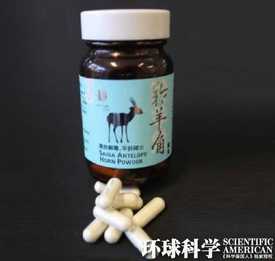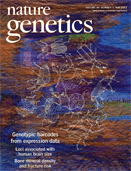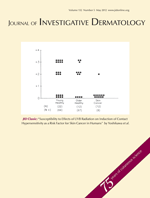PNAS & PLoS Genet.:德国研究称部分中药或对人体有害可致癌
2012-05-19 网易探索 网易探索
图注:科学家发现,中药产品当中,一些原材料取自于濒危动物物种,例如亚洲黑熊和高鼻赛加羚羊。但是,科学家在一瓶写着产品100%取自高鼻赛加羚羊的中药当中提取到了大量山羊和绵羊的DNA,说明生产商对药品真实成分有所隐瞒。 近日发表的两篇研究报告表明,部分中医疗法或对人体有害。科学家此次利用分子基因学对部分中药成品进行了分析检验,发现其中有些药材成分并未写在产品说明项当中,有些药材成分甚至已被列为非法

图注:科学家发现,中药产品当中,一些原材料取自于濒危动物物种,例如亚洲黑熊和高鼻赛加羚羊。但是,科学家在一瓶写着产品100%取自高鼻赛加羚羊的中药当中提取到了大量山羊和绵羊的DNA,说明生产商对药品真实成分有所隐瞒。
近日发表的两篇研究报告表明,部分中医疗法或对人体有害。科学家此次利用分子基因学对部分中药成品进行了分析检验,发现其中有些药材成分并未写在产品说明项当中,有些药材成分甚至已被列为非法药物,如果患者服用,有可能会诱发癌症。
德国纽伦堡生物医学和药物研究所(Institute for Biomedical and Pharmaceutical Research)的负责人弗里茨·索吉尔(Fritz Sorgel)表示:“这两份研究十分清楚的表明,中药也有可能对人体造成危害。公众应当对中药可能对自己的身体造成危害这个事实有更加清醒的认识。”索吉尔此次并未参与这两项研究,因而他的论述较为客观。
据悉,每年全球消费者花费在中医产品方面的金钱总额达到数亿美元,其中通过互联网渠道购买中医药的比例也越来越大。一些科学家希望通过分析中药成分,来发现新的药学物质。2011年,中国科学家屠呦呦因发现青蒿素—一种用于治疗疟疾的药物而获得拉斯克奖(Lasker award)临床医学奖,并且离获得诺贝尔奖只有一步之遥,因为自1997年以来的诺贝尔生理学或医学奖获得者中,近一半也是拉斯克奖得主。屠呦呦正是从中药黄花蒿中提取到了青蒿素,从而获得了国际医学界的肯定。她的成功也引发了科学家对于中药的关注,不少人都希望复制屠呦呦的成功模式。
不过,对于中药,一直以来都有科学家在提出批评意见。他们认为,部分中药可能含有天然有毒物质,例如重金属污染物,并且中药添加物当中也有可能含有类固醇类物质,长期服用会对人体产生副作用。此外,一些科学家通过分析中药成分发现,部分中药当中含有用濒危动物器官或者骨骼制作而成的药材成分。
在此次研究中,澳大利亚莫道克大学(Murdoch University)的研究人员利用现代基因测序技术,对15例传统中药材进行了彻底分析。分子基因学家迈克尔·邦斯(Michael Bunce)解释称:“我们从澳大利亚边境官员缴获的中药材中得到了这些样品,然后把它们碾磨成粉末,再从其中提取DNA样本。”通过观察分析,科学家提取了两个比较具体的基因样本,一个是植物当中常见的trnL叶绿体基因;而另一个则是动植物均可保留的16srRNA基因。科学家随即对这两个基因进行了复制,并且利用测序技术观察它们的DNA序列。科学家通过将测序结果同基因数据库中的原始数据进行对比,可精确查出这些中药具体采用了哪些动植物作为药材来源。邦斯解释称,“有些时候,我们只有一个特定的DNA,要想搞清楚其来源真的很困难,但随着基因数据库的不断扩容,如今这件事情要做起来变得越来越简单。”
科学家通过分析发现,这些中药当中,一些原材料取自于濒危动物物种,例如亚洲黑熊和高鼻赛加羚羊(Saiga antelope),不过,生产商一般会在包装或者说明书上明确标明,其药品含有此类成分。但生产商也经常会隐瞒一些药品成分,并不会写到包装或者说明书当中去。例如,科学家在一瓶写着产品100%取自高鼻赛加羚羊的中药当中提取到了大量山羊和绵羊的DNA。科学家的这项研究成果在线发表在4月12日的《公共科学图书馆—遗传学》(PloS Genetics)杂志当中。
德国柏林莱布尼茨学会负责动物园和野生动物研究(Leibniz Institute for Zoo and Wildlife Research)的科学家莱克菲尔德(Dietmar Lieckfeldt)表示:“利用DNA序列来识别动物种族,这种方法非常精确可靠,通过这种方法我们发现部分中药产品涉及到非法动物贸易活动。”他介绍称,这种DNA识别技术已经得到一段时间的应用,但下一代测序技术有可能让科学家在大量DNA当中,能够很快的识别不同种族。
通过对中药产品进行分析,邦斯和他的同事共发现68个不同的植物品种,其中就包括麻黄属植物(Ephedra)及细辛(Asarum),二者均含有有毒化学成分,例如可导致服用者患上肾疾病、肾衰竭及上尿路癌症的马兜铃酸。目前,很多国家都已禁止出售任何含有马兜铃酸的药品。
近期有关马兜铃酸能导致肾衰竭及上尿路癌症的相关研究也引起了科学界的普遍重视。纽约州立大学石溪分校(Stony Brook University)的药物学家亚瑟·格罗尔曼(Arthur Grollman)本周在《美国国家科学院学报》(Proceedings of the National Academy of Sciences)期刊上发表论文称,马兜铃酸也有可能是部分地区肾病患病率一直居高不下的主要因素。例如在中国台湾地区,马兜铃一直被当做中草药广泛用于传统医学,而台湾地区的肾病发病率也高的惊人。此前有调查分析表明,台湾肾病患者当中,有三分之一的人都有在医生处开设过含马兜铃属植物的药材。
同时,邦斯和他的同事还发现,部分中药当中存在不能同其他药物混用的药品成分,一旦使用者进行混用,有可能造成健康威胁。
邦斯表示:“有些中药产品对成分列表有所隐瞒,并且也不精确,这些都会对使用者的健康造成隐患。”索吉尔则称,他们的研究表明,传统中药就像一把双刃剑,有利有弊,在没有对其了解通透的情况下,应当谨慎使用。

doi:10.1371/journal.pgen.1002657
PMC:
PMID:
Deep Sequencing of Plant and Animal DNA Contained within Traditional Chinese Medicines Reveals Legality Issues and Health Safety Concerns
Megan L. Coghlan1, James Haile1, Jayne Houston1, Dáithí C. Murray1, Nicole E. White1, Paula Moolhuijzen2, Matthew I. Bellgard2, Michael Bunce
Traditional Chinese medicine (TCM) has been practiced for thousands of years, but only within the last few decades has its use become more widespread outside of Asia. Concerns continue to be raised about the efficacy, legality, and safety of many popular complementary alternative medicines, including TCMs. Ingredients of some TCMs are known to include derivatives of endangered, trade-restricted species of plants and animals, and therefore contravene the Convention on International Trade in Endangered Species (CITES) legislation. Chromatographic studies have detected the presence of heavy metals and plant toxins within some TCMs, and there are numerous cases of adverse reactions. It is in the interests of both biodiversity conservation and public safety that techniques are developed to screen medicinals like TCMs. Targeting both the p-loop region of the plastid trnL gene and the mitochondrial 16S ribosomal RNA gene, over 49,000 amplicon sequence reads were generated from 15 TCM samples presented in the form of powders, tablets, capsules, bile flakes, and herbal teas. Here we show that second-generation, high-throughput sequencing (HTS) of DNA represents an effective means to genetically audit organic ingredients within complex TCMs. Comparison of DNA sequence data to reference databases revealed the presence of 68 different plant families and included genera, such as Ephedra and Asarum, that are potentially toxic. Similarly, animal families were identified that include genera that are classified as vulnerable, endangered, or critically endangered, including Asiatic black bear (Ursus thibetanus) and Saiga antelope (Saiga tatarica). Bovidae, Cervidae, and Bufonidae DNA were also detected in many of the TCM samples and were rarely declared on the product packaging. This study demonstrates that deep sequencing via HTS is an efficient and cost-effective way to audit highly processed TCM products and will assist in monitoring their legality and safety especially when plant reference databases become better established.

doi:10.1073/pnas.1119920109
PMC:
PMID:
Aristolochic acid-associated urothelial cancer in Taiwan
Chung-Hsin Chena,b, Kathleen G. Dickmanc,d, Masaaki Moriyac, Jiri Zavadile, Viktoriya S. Sidorenkoc, Karen L. Edwardsf, Dmitri V. Gnatenkod, Lin Wug, Robert J. Tureskyh, Xue-Ru Wui,j, Yeong-Shiau Pua,1, and Arthur P. Grollman
Aristolochic acid, a potent human carcinogen produced by Aristolochia plants, is associated with urothelial carcinoma of the upper urinary tract (UUC). Following metabolic activation, aristolochic acid reacts with DNA to form aristolactam (AL)-DNA adducts. These lesions concentrate in the renal cortex, where they serve as a sensitive and specific biomarker of exposure, and are found also in the urothelium, where they give rise to a unique mutational signature in the TP53 tumor-suppressor gene. Using AL-DNA adducts and TP53 mutation spectra as biomarkers, we conducted a molecular epidemiologic study of UUC in Taiwan, where the incidence of UUC is the highest reported anywhere in the world and where Aristolochia herbal remedies have been used extensively for many years. Our study involves 151 UUC patients, with 25 patients with renal cell carcinomas serving as a control group. The TP53 mutational signature in patients with UUC, dominated by otherwise rare A:T to T:A transversions, is identical to that observed in UUC associated with Balkan endemic nephropathy, an environmental disease. Prominent TP53 mutational hotspots include the adenine bases of 5′AG (acceptor) splice sites located almost exclusively on the nontranscribed strand. A:T to T:A mutations also were detected at activating positions in the FGFR3 and HRAS oncogenes. AL-DNA adducts were present in the renal cortex of 83% of patients with A:T to T:A mutations in TP53, FGFR3, or HRAS. We conclude that exposure to aristolochic acid contributes significantly to the incidence of UUC in Taiwan, a finding with significant implications for global public health.
本网站所有内容来源注明为“梅斯医学”或“MedSci原创”的文字、图片和音视频资料,版权均属于梅斯医学所有。非经授权,任何媒体、网站或个人不得转载,授权转载时须注明来源为“梅斯医学”。其它来源的文章系转载文章,或“梅斯号”自媒体发布的文章,仅系出于传递更多信息之目的,本站仅负责审核内容合规,其内容不代表本站立场,本站不负责内容的准确性和版权。如果存在侵权、或不希望被转载的媒体或个人可与我们联系,我们将立即进行删除处理。
在此留言














#Gene#
78
#NET#
58
#PNAS#
71
#Genet#
64
#致癌#
64
#德国#
68